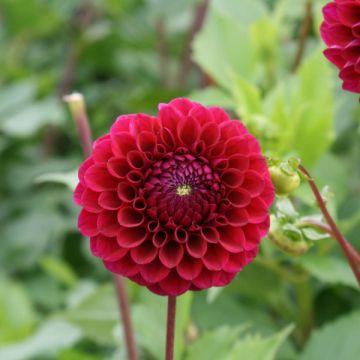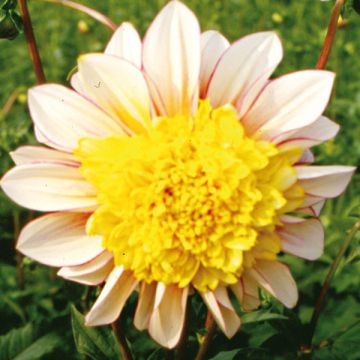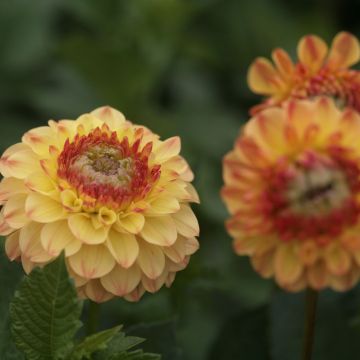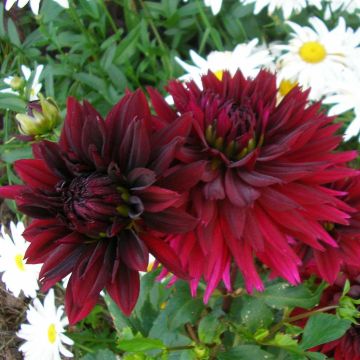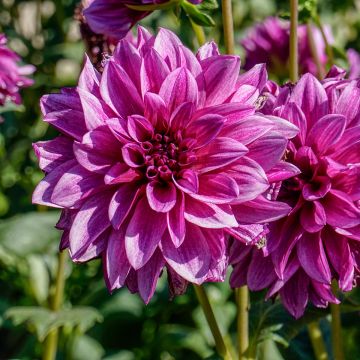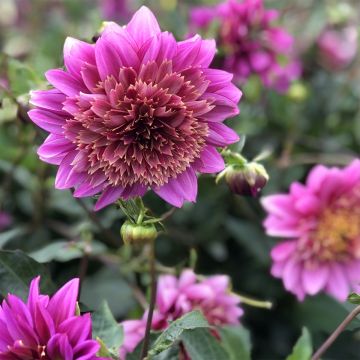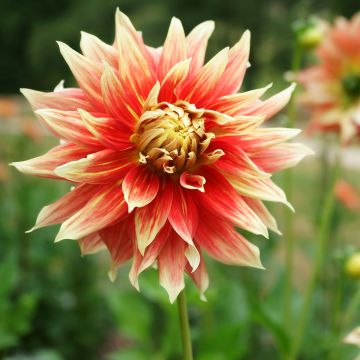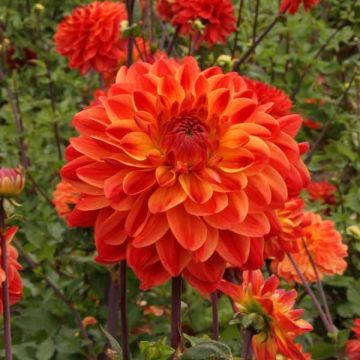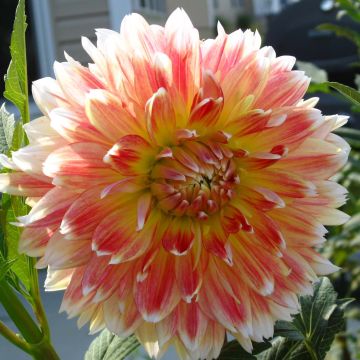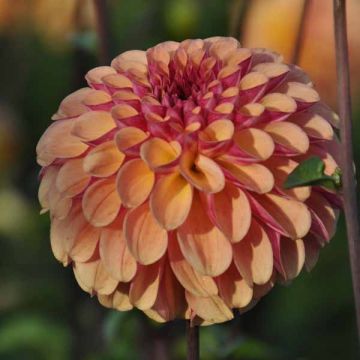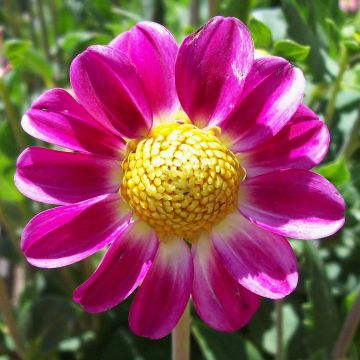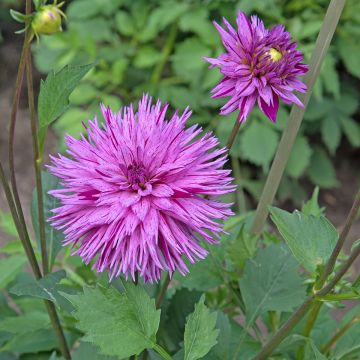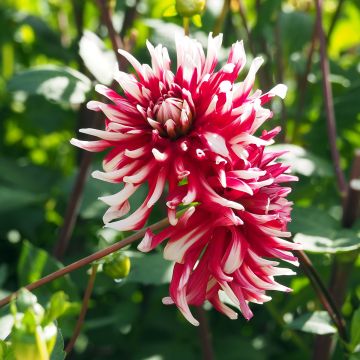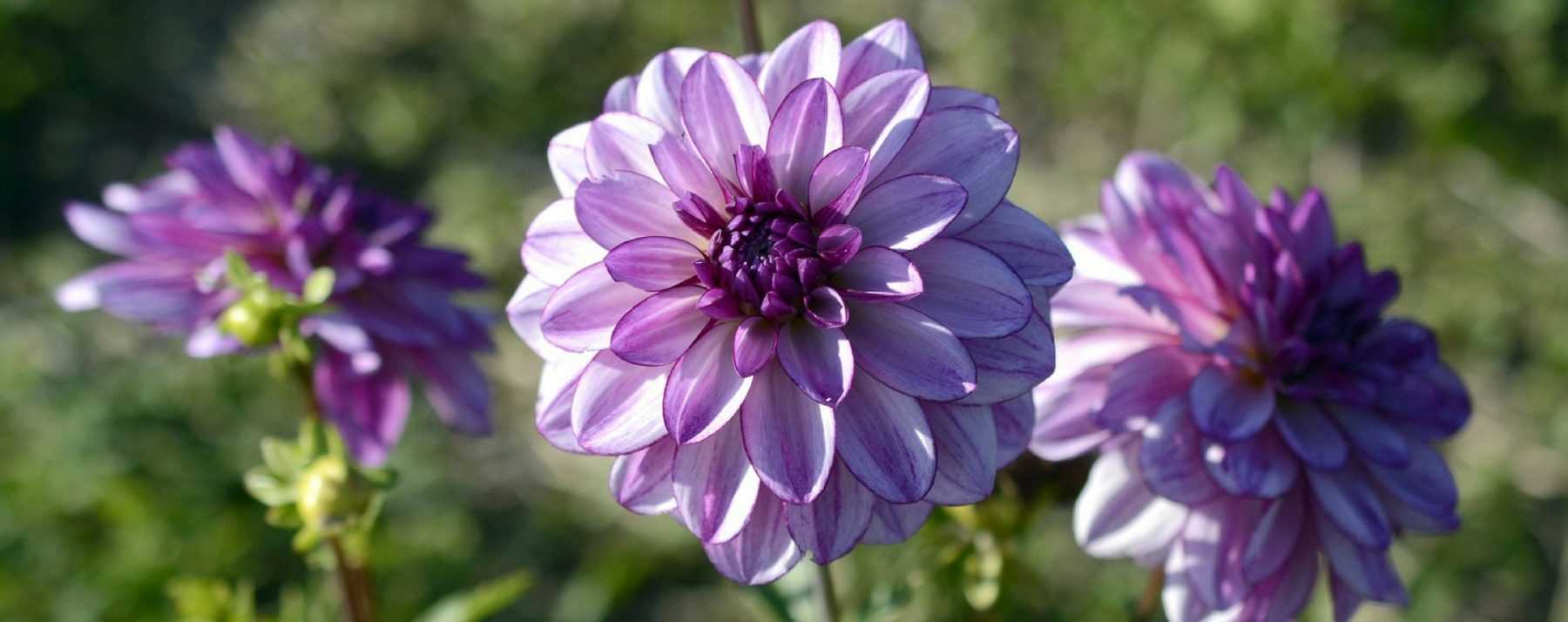
Dahlia: Planting, Care and Growing Tips
Contents
The Dahlia in a Few Words
- Dahlias bloom abundantly and for a long period. Their continuous flowering begins in summer and lasts until the onset of winter.
- Their flowers, described as camellia, anemone, cactus, pompon or peony-shaped, come in an endless variety of forms and hues.
- From towering giants reaching up to 2m to compact dwarfs under 60cm tall, there are hundreds of Dahlia varieties suited to every garden.
- Not fully hardy in most regions, their tubers need lifting and storing frost-free over winter.
- They’re essential flowers for cottage gardens, vibrant exotic borders, vegetable plots, mixed borders, containers and summer bouquets.
Our expert's word
With its charmingly old-fashioned or strikingly graphic appearance and its endlessly variable colours, the Dahlia has made a spectacular comeback in recent years, once again gracing naturalistic gardens as well as vegetable patches, summer flower beds in single or multicoloured schemes, and mixed borders or containers, to which it adds a romantic, whimsical or exotic touch.
Classic or extravagant, sophisticated or simple, understated or exuberant, miniature or giant, this summer-flowering bulb belongs to a vast family with varied forms, colours and dimensions, offering limitless choices for gardeners. Dahlias in the garden promise a summer bursting with colour – why miss out?
Their single or fully double blooms, with anemone, cactus or pompon-shaped flowers, range from vibrant to pastel in countless shades. Bronze-tinged orange, coppery pink or magenta-apricot, straw yellow, crimson red, pristine white, lilac-blue or deep indigo violet – they bloom non-stop throughout summer and into autumn, from July to October, creating fresh, colourful and original bouquets.
Whether it’s a “ball” Dahlia, “giant” or “dwarf”, “bedding”, “decorative”, “collarette”, “cactus” or “semi-cactus”, or “landscape” Dahlia, you’re sure to find the perfect Dahlia among the 200+ varieties available online, including some exclusive selections we offer in the finest available sizes.
Dare to invite them into your garden to create dazzling, colourful displays!
Botany and description
Botanical data
- Latin name Dahlia
- Family Asteraceae
- Common name Dahlia
- Flowering De juillet à novembre
- Height 0,15 à 2 m
- Exposure Soleil
- Soil type Neutre
- Hardiness Semi-rustique (pas au-delà de -5°C) craint le gel
Native to the highlands of Mexico and Central America, the Dahlia belongs to the large Asteraceae family, like daisies, asters or echinaceas. There are 30 species and close to tens of thousands of cultivars: today nearly 20,000 horticultural varieties are present worldwide. Most are derived from Dahlia pinnata and D. coccinea. Discovered in the 16th century, the Dahlia was only introduced to Europe two centuries later. The Dahlia imperialis, the botanical species which bore single flowers, was then very different from the modern Dahlia.
From its origins in the dry Mexican landscapes, it has retained its love for heat and sun but a congenital sensitivity to cold! Moderately hardy, the Dahlia is very sensitive to cold, its tubers must be overwintered in most of our regions as it fears frost. It cannot withstand temperatures consistently and frequently below -5°C. But, stored all winter well protected from frost, it will flower again for years to come.
Today, the Dahlia has become popular everywhere in France, found in all summer flower beds. There are two main types: large-flowered Dahlias with tubers and dwarf bedding Dahlias easily propagated by seed. Among the most appreciated and widespread: Anemone-flowered Dahlias, Orchid-flowered Dahlias, Collarette Dahlias, Decorative Dahlias, Pompon and Ball Dahlias, Cactus and Semi-Cactus Dahlias, Giant Dahlias, Dwarf Dahlias single and double.
The Dahlia is part of a vast family with very varied forms, colours and heights. The tallest specimens easily reach 1.50m in height, even more in fertile soil, with a spread of 45 to 80cm. Among them is the Dahlia Imperialis, the botanical ancestor of the Dahlias in our gardens which can reach up to 3m in height. Intermediate Dahlias grow between 80cm and 1.10m. The dwarf varieties, between 0.25 and 0.70cm, do not require staking.
This perennial has swollen, tuberous roots, clustered together like small potatoes. Edible, they were initially cultivated for consumption. But their rather tasteless roots were quickly abandoned in favour of the plant’s exceptional flowering.
From its bushy, erect clump emerge rigid, tubular, upright, hollow and branched stems bearing inflorescences from July to October (until November in temperate climates) that renew themselves all summer without interruption.
The Dahlia flower has a strong character, such a pronounced, exuberant personality that it stands out among thousands. Its solitary capitulum inflorescences are formed by one or more rows of radiating ligules surrounding, depending on the variety, a central disc of more or less visible pistils. The flower diameter varies from 10cm to 25cm or more! They are classified by the size of their inflorescences:
- Giant: over 25cm in diameter (Giant Dahlias)
- Large: 20 to 25cm in diameter (Cactus Dahlias, Ball Dahlias)
- Medium: 15 to 25cm in diameter (Waterlily-flowered Dahlias)
- Small: 10 to 15cm in diameter (Anemone-flowered Dahlias, Collarette Dahlias, Decorative Dahlias)
- Miniature: under 10cm in diameter (Pompon Dahlias)
Giant Dahlias, like the Dahlia ‘Emory Paul’, bear enormous flowers that can reach up to 35cm in diameter, the size of a plate.
The other variable of the Dahlia is its flower shape, which forms the basis of classification. These ligulate, unscented flowers are single, semi-double or very double. The shape of the ligules varies by cultivar: rolled, flat, lacy…
The Decorative Dahlias have no central disc but large double flowers with generally flat petals, rounded at the tip and slightly curved, sometimes resembling a waterlily or a camellia flower. The elegant Semi-Cactus or Cactus Dahlias bear long, rolled and pointed petals forming a shaggy pompon centre reminiscent of a cactus flower like the Dahlia Mel’s Orange Marmalade. In this group, the narrow, very tapered ligules of the capitulum are rolled for more than half their length. The ‘lace’ cactus are characterised by large, cut flowers with tapered petals, flat or rolled and ending in forked tips, resembling lace.
Others, formed by a crown of wider ligules surrounding a very double centre of smaller florets, resemble an anemone. Some Dahlias have long, curved or reflexed ligules, arranged in a star shape recalling an orchid.
The Collarette Dahlias or single-flowered Dahlias have just a simple crown of petals around a central disc encircled by an inner collar of shorter ligules (the centre and tips often offer a striking contrast as in the Dahlias ‘Pooh’ or ‘Fashion Monger’).
Full of whimsy, the Honka Dahlias bear star-shaped flowers, with thin, very rolled and separated petals around an orange centre, making them resemble delicate windmills or curious spiders.
At the opposite end are the very graphic Pompon Dahlias, whose tubular ligules form a spherical inflorescence about 10cm for the largest, sometimes flattened at the top, with a honeycomb-like structure, similar to a beehive like the Dahlia ‘Burlesca’. The Ball Dahlias bear flowers similar to pompon Dahlias, but larger, with a diameter that can reach 12cm.
Dahlia flowering offers an incredible richness of colour: its flowers come in an infinite palette ranging from light pink to lilac pink, from wine-lees to crimson red, from apricot to carmine salmon, from pure white to café au lait or primrose yellow, from indigo violet to lilac blue (‘Worton Blue Streak’ is the bluest cactus at the moment!).
With excellent vase life, Dahlia flower heads make wonderful summer bouquets full of colour. Some varieties like the Dahlia ‘Karma Lagoon’ have been specially developed for cut flowers.
Deciduous, the abundant foliage brings a certain lushness and highlights the exotic colours and voluptuous shapes of the flowers. The opposite, finely toothed leaves, 20 to 50cm long, are either pinnate or very rounded and divided into three to five leaflets, more or less leathery. The foliage colour also offers beautiful variations, ranging from tender green to emerald green or bronze green or even purple (Decorative Dahlia ‘Purple Flame’, Happy Single ‘Juliet’, Dahlia Happy Single ‘Flame’) depending on the different types.
Contrary to popular belief, the Dahlia is not difficult to grow, but does require some attention. It will only be happy and floriferous in warm and sunny conditions. While it adapts to all soils, it thrives in fertile soil, rich in humus, fresh and well-drained, preferably neutral, neither acidic nor chalky. It likes light soils, but which remain fresh and kept sufficiently moist with a good mulch during the growing season. The Dahlia does not tolerate stagnant water, especially in spring and autumn. Fresh soil allows it to develop vigorously. It requires, to flower well, soil rich in organic matter. It will never be lush and will struggle in poor, sandy soil. Tall Dahlias are quite resistant to wind or heavy rain. If you want to avoid rather unsightly staking, it’s better to give them a place sheltered from prevailing winds which could make the stems bend.
A staple of cottage gardens, the Dahlia is a versatile flowering plant that brings colour, texture and originality to borders, rockeries, flower beds, containers as well as the vegetable garden. The Dahlia can be grown alone, but is preferably planted in groups, in the middle or at the back of sunny borders, combined with grasses, other vigorous perennials that will act as supporters, preventing their flowering stems from bending unattractively. Dwarf varieties are reserved for borders or planters. Magnificent in borders, Decorative Dahlias make excellent cut flowers for bright, colourful summer bouquets.
This plant was named “dahlia” in honour of the Swedish botanist Andreas Dahl.
Main species and varieties
There are 30 species and close to tens of thousands of Dahlia hybrids: today, nearly 20,000 horticultural varieties are found worldwide. Most are derived from Dahlia pinnata and D. coccinea. Discover our vibrant collection of Dahlias, varied in flower shape and an endless palette of colours. They are classified by flower form and diameter, from dwarf to giant. From the most classic to the most surprising—whether “ball,” “giant,” or “dwarf,” “bedding,” “collarette,” “decorative,” “cactus” or “semi-cactus,” “Honka,” “orchid-flowered,” “anemone-flowered,” or “camellia-flowered”—you’ll surely find the perfect Dahlia among the 200+ varieties we offer, including some exclusive selections in the finest available sizes. Dare to mix, pair, and combine them—they’ll brighten up your rockeries, flower beds, containers, and mixed borders for months on end!
These are characterised by large blooms with a ring of flattened petals surrounding a densely double centre of smaller florets. Their unique, sometimes contrasting colours inevitably catch the eye. They include tall varieties perfect for perennial borders as well as compact types ideal for pots or stunning summer bouquets.
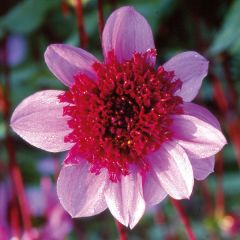
Dahlia Blue Bayou
- Flowering time August to November
- Height at maturity 1 m
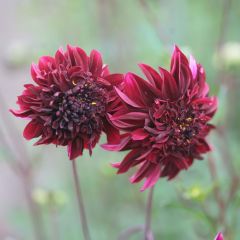
Dahlia Anemone Soulman
- Flowering time August to November
- Height at maturity 70 cm
This horticultural category is defined by their flower shape—resembling a cactus bloom! They bear very large double flowers, 12–20 cm across, with a delightfully ruffled appearance and pointed, tightly rolled petals. Semi-cactus varieties have similar blooms but with narrower, less tightly curled petals. The tallest make striking focal points at the back of borders, while dwarf cactus Dahlias (under 60 cm tall) are perfect for edging or front-of-border planting.
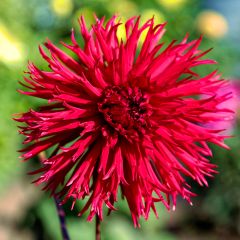
Dahlia Urchin
- Flowering time August to November
- Height at maturity 1 m

Dahlia Blue Record
- Flowering time August to November
- Height at maturity 60 cm
This group features single blooms with a contrasting, ruffled centre. The broad, flat outer petals form a neat ring around a collar of shorter petals, revealing a yellow heart. The collar, often in a different colour, creates striking contrast. Dwarf varieties (under 40 cm tall) are sensational in flower borders and pots.
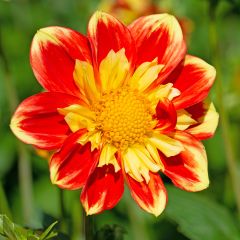
Dahlia 'Pooh'
- Flowering time August to December
- Height at maturity 1,20 m
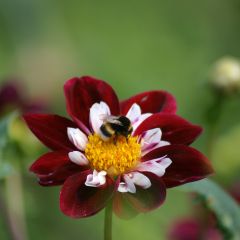
Dahlia 'Impression Fantastico'
- Flowering time August to December
- Height at maturity 40 cm
These stand out with their large, full double blooms composed of numerous broad, flat petals with rounded or slightly curled tips. This diverse group includes giants with flowers over 20 cm across as well as smaller varieties evoking camellias, waterlilies, or chrysanthemums.
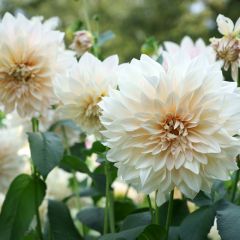
Dahlia Café au Lait
- Flowering time August to November
- Height at maturity 1,20 m

Dahlia Duke Duweno
- Flowering time August to December
- Height at maturity 80 cm
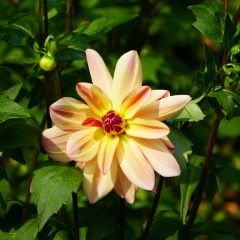
Dahlia Happy Butterfly
- Flowering time August to November
- Height at maturity 1,10 m
These bear the largest flowers of all. Majestic in stature, their stems reach up to 1.5 m tall, topped by plate-sized blooms up to 35 cm across! With their subtle or intense colours, they make spectacular backdrops in perennial borders or vegetable gardens. Staking is often required.
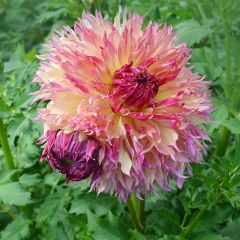
Dahlia Myrtle's Folly
- Flowering time August to November
- Height at maturity 1,20 m
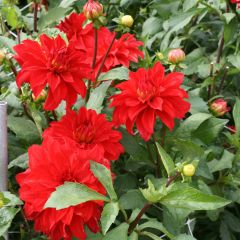
Dahlia Barbarossa
- Flowering time August to November
- Height at maturity 1,20 m
Their compact size makes them ideal for pots, containers, or edging flower beds. This group includes the Gallery Dahlias (around 45 cm tall), offering continuous blooms in opulent colours and forms; dwarf cactus Dahlias (50–60 cm tall), stunning with their large double blooms; and the Happy Single collection, with vibrant single blooms reaching 60–80 cm.
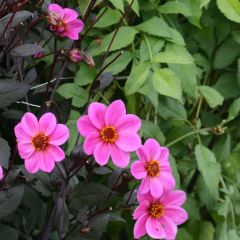
Dahlia Happy Single Juliet
- Flowering time August to November
- Height at maturity 60 cm
These are distinctive for their perfectly spherical, honeycomb-like blooms. The difference between pompons and balls lies in size: pompons are smaller (up to 10 cm), while balls range from 6–12 cm. These spherical flowers are perfect for creating rounded bouquets and adding a graphic, colourful touch to borders.
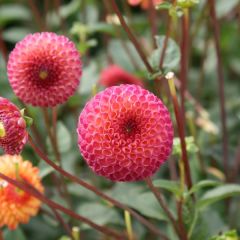
Dahlia Pompom Burlesca
- Flowering time August to November
- Height at maturity 90 cm

Dahlia Icoon
- Flowering time August to November
- Height at maturity 1 m
Discover other Dahlias
Planting dahlias
When to Plant?
With Dahlias, haste makes waste – timing is key: planted too early, the first shoots risk being devoured by slugs. Tubers stored indoors over winter should be planted in spring, in March after the last frosts. In colder regions, wait until late April or early May, once the soil has warmed and can be worked. Simply store purchased tubers in their packaging in a frost-free spot until the right planting time.
Where to Plant?
Dahlias grow almost anywhere in France. The essential condition for thriving dahlias is planting them in full sun. Second requirement: choose well-drained soil where water doesn’t pool, especially in spring and autumn. Dahlias prefer light soils that stay cool and sufficiently moist with good mulching during the growing season. Waterlogged conditions, however, may cause tuber rot.
Though they adapt to most soils (avoiding overly acidic or chalky ground), they flourish in fertile garden soil, rich in humus, cool, well-drained, and preferably neutral. Dahlias are greedy feeders: to bloom well and grow vigorously, they need rich soil preparation. If unsure about soil fertility, add compost or manure in autumn.
Tall Dahlia varieties struggle in strong winds or heavy rain. Exposed sites may dry foliage or topple stems. Shelter them from prevailing winds. Staking may be essential for tall Dahlias to support flower heads, preventing stems from snapping in gusts, especially when grown alone. To avoid flopping in mixed borders, plant Dahlias alongside other plants or shrubs for natural support.
When planting, allow adequate space in borders. Ensure each plant remains accessible for feeding, staking, disbudding, and winter storage.
While adaptable to any garden setting, Dahlias shine as mid-border or backdrop plants, adding vibrant colour.
Dwarf varieties suit sunny beds, path edging, or container growing on terraces or balconies. Potted Dahlias need quality compost, regular watering, and bulb fertiliser.
How to Plant?
Dahlias are heavy feeders. To meet soil nutrition needs, dig in compost or manure in autumn or just days before planting. For heavy soils, mix in grit and compost to improve drainage.
Planting Tubers
From mid-April, once soil is workable, plant your Dahlias:
- Space tall varieties 80–100 cm apart
- Space compact varieties 30–50 cm apart
- Prepare a 20 cm-deep hole, blending in a handful of bone meal or dried blood with crumbled garden soil. Dahlias crave rich soil.
- Position tubers with the crown 5 cm below soil level.
- Cover with 10 cm of soil.
- Insert stakes for tall varieties (avoid damaging tubers) – this also marks planting spots!
- Water thoroughly, then regularly for 6 weeks to establish roots.
- Scatter slug pellets to protect emerging shoots.
- Mulch once plants are established.
→ Also read: Planting Dahlias: 8 Common Mistakes to Avoid and How to Force Dahlias for Earlier Blooms
Read also
How to grow beautiful dahlias?Overwintering dahlia tubers
Dahlias are extremely sensitive to cold and fear frost. In regions with harsh winters where temperatures regularly drop below -5°C, lifting the tubers is essential if you wish to keep them alive. In areas with mild winters where frosts are light and infrequent, and in well-draining sandy soil, the tubers can remain in the ground over winter, simply protected by a thick mulch of dry leaves or straw. Lifting the tubers allows for division and potting up to encourage earlier flowering.
In late October or early November (not before, as the roots would not have sufficient reserves for winter), when the plant weakens and the first frosts begin to blacken the leaves, it’s time to dig up the tuberous clumps. The goal is simple: to protect them from frost!
- Once the foliage has blackened from frost, cut the stems back to 15 cm above ground level.
- Carefully dig up the tubers using a garden fork.
- Remove as much soil as possible from between the tubers.
- Label each clump at the base of the stem to easily identify them in spring.
- Place the tubers on a layer of peat, dry sand, or dry leaves in a cardboard box or deep crate.
- Cover the tubers with a layer of peat or dry leaves.
- Store them away from light, draughts, rodents, and—most importantly—frost in a dry, cool, well-ventilated, and dark location where temperatures do not exceed 4–5°C (such as a dry cellar, frost-free garage, or attic). Under these ideal conditions, dahlias store very well with minimal risk of loss.
- Regularly check the tubers for signs of disease.
→ Read also: How to overwinter dahlias to protect them from frost? and Overwintering Dahlias: Should You Lift Them?
Care and Maintenance
Dahlias are relatively easy to grow but do require some attention. A few simple steps will ensure a summer full of blooms.
- In spring, protect young shoots from slugs.
- During the growing season, Dahlias are thirsty plants. Water generously when buds are forming.
- In July, mulch with a 2 cm layer of dry straw or peat to retain moisture throughout summer. Water the mulch.
- Stake the stems of tall varieties if needed as the plant grows.
- Tie in young stems
- 2-3 weeks after planting, pinch out the growing tip to encourage branching and more flowers, especially if the tubers produce only a single stem. This will create a bushier plant that is more resistant to bad weather and may not need unsightly staking.
- For larger blooms, pinch out side buds.
- Remove small shoots at leaf axils – flower heads will grow bigger as a result.
- Deadhead spent flowers to encourage new blooms and extend the flowering period.
- Water regularly, twice weekly in hot weather, at the base of the plant rather than on foliage.
- In late summer, apply organic fertiliser to boost growth.
- In autumn, work well-rotted manure or compost into the garden soil.
Pests and Diseases
Dahlias are vulnerable to slug attacks in spring when tender young shoots emerge – use fern manure or wood ash as deterrents. Later in the season, aphids may target young stems with buds – treat with diluted black soap. Earwigs adore tender petals but their feeding doesn’t harm the plant’s health. Deficiency symptoms (thin stems, yellow leaves, stunted growth) indicate poor nutrition – apply compost mulch and complete fertiliser. Grey mould can affect tubers in excessively damp conditions.
→ Learn more about dahlia pests and diseases in our advice sheet!
Propagation
By cuttings
This is the best way to obtain a large number of plants, but it is rather tedious; we recommend dividing your tubers instead. Cuttings are taken from tubers that have been pre-sprouted. In early March, bring out the roots stored all winter and place them in a fresh mixture of compost or moist peat. It will take about three weeks for shoots to appear. Take the cuttings when these shoots reach around ten centimetres in length. Potted under a cold frame and then repotted, they can be planted out in early June.
By dividing tubers
This is the simplest method. It can be done just before planting.
- In spring, around late March, take the roots that have overwintered in storage.
- Use a sharp knife or secateurs to divide the tubers into two or three pieces, ensuring each has a portion of the old stem with an eye, from which new shoots will emerge.
- Dust the cuts with charcoal.
- Only plant in mid-April to early May if small buds have appeared; otherwise, wait and water to encourage their growth.
Watch our video tutorial on dividing dahlias:
To learn more, check out our tutorial: How to Multiply Dahlias: The Right Steps. Also read: How to Sow Dahlias?
Pairing
A staple of cottage gardens, the Dahlia is a versatile flowering plant that brings colour, texture and originality to borders, rockeries, flower beds, containers as well as the vegetable garden. Dahlias can be grown as standalone specimens but are best planted in groups in the middle or back of sunny borders, paired with ornamental grasses (Panicum, Molinia, Calamagrostis) or other vigorous perennials (Cosmos, Asters, Echinacea, Cannas) which will act as natural supports, preventing their flower stems from flopping unattractively.
The Landscape, Pompon or Honka varieties with pointed petals create airy displays. Compact varieties like the Gallery series or dwarf Happy Single dahlias, as well as Collerette types (‘Impression Fantastico‘), are ideal for edging or containers. Stunning in borders, decorative Dahlias also make excellent cut flowers for bright, colourful summer bouquets.
Need more inspiration? Explore our guide: “Dahlias: Perfect Pairings for Your Garden”
Useful resources
- The most beautiful dahlia collection is here; Our new gladioli and dahlias for spring 2022; Our new Dahlias for spring 2023
- All our new dahlias are on our website!
- 3 styles with dahlias, to discover on our blog
- Don’t miss planting your dahlias, follow our advice!
- How to divide your dahlias? All the tips in our advice sheet
- Discover how to overwinter your dahlias with our video tutorial
- Should you lift dahlias? Find out with Ingrid on our blog
- Indigo violet, mahogany or pale pink, with Sophie, discover the full colour palette of dahlias on our blog
- See dahlias at Parc floral de Paris, officially recognised as a botanical garden since 1998, it features several hundred varieties of dahlias!
- Discover our 7 ideas for beautiful summer container combinations
- Find out how to grow Dahlias in pots
- Discover the best ball dahlias
- Learn how to pinch dahlias for more flowers
- Discover 5 giant Dahlias to plant at the back of borders
- Find our tips for growing dahlias in hot weather
- We present 5 Dahlias for border planting
- A dahlia bouquet for €1, is it possible? Find out in our article!
- Subscribe!
- Contents







































